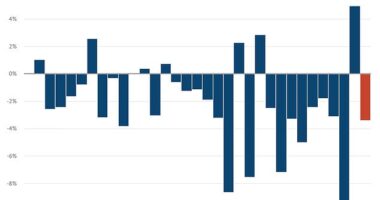
The perfect recipe for a healthy bones in a child is a daily mixture of vigorous activity, time sitting still and up to 11 hours of sleep, a new study revealed.
Experts from the University of South Australia examined 804 children aged between 11 and 13 years old to work out the perfect ‘Goldilocks Day’ for bone health.
Physical activity is vital for bones health, the team said, so they set out to determine what could be changed or removed to increase activity levels in an average day.
Children should spend up to 90 minutes a day playing sports or running and 3.4 hours per day doing light activities such as walking or doing household chores.
The rest of the ‘ideal day’ is then made up of eight hours of sedentary time including reading, studying and going to school and 11 hours in bed asleep at night.


The perfect recipe for a healthy bones in a child is a daily mixture of vigorous activity, time sitting still and up to 11 hours of sleep, a new study revealed
Lead researcher, Dr Dot Dumuid says that the findings provide valuable insights for parents, caregivers and clinicians in planning the day to ensure healthy bones.
‘Children’s activities throughout the whole 24-hour day are important for their bone health, but until now, we haven’t known the perfect combination.’
Dumuid said higher levels of physical activity are good for bone health in children – but you ‘can’t increase exercise without impacting their other activities’.
‘In this study, we looked at the interrelating factors of physical activity, sedentary time and sleep, finding an ideal combination that delivers the best daily balance.
‘The ‘Goldilocks Day’ tells us the durations of physical activity, sleep and sitting that are ‘just right’ for children’s optimal bone health.’
Understanding the best combination of activities for bone growth in younger children is important, as peak bone mass is achieved by age 18-20.
‘Optimising bone health in children is a key protector against osteoporosis, the leading preventable cause of fracture in adults and a major public health problem with considerable economic and societal costs,’ said Dumuid.
Osteoporosis is a major problem around the world, affecting up to 200 million people, including over 3 million in the UK – with 500,000 fractures each year as a result of the condition.


Lead researcher, Dr Dot Dumuid says that the findings provide valuable insights for parents, caregivers and clinicians in planning the day to ensure healthy bones.
In this study, participants were selected from the Child Health CheckPoint study within the Longitudinal Study of Australian Children.
Activity data was collected through accelerometer readings – worn all day for eight days – and supplemented by self-recorded logs for bed and wake times.
Bone measures were recorded using peripheral QCT scans of the leg to identify bone density and geometric parameters in each of the participants.
Dr Dumuid says the study also highlights the importance of sleep, especially for boys, suggesting they get up to 11 hours every night.
‘We always talk about getting enough exercise to help build bones, but for children, it’s vital that they also get enough sleep,’ the researcher said.
‘Curiously, the study also showed that sleep is more important for boys’ bone health than for girls, with boys needing an extra 2.4 hours of sleep a day.
‘However, boys tended to be at earlier stages of pubertal development than girls, causing us to speculate that the need for longer sleep is related to rapidly changing hormonal processes rather than gender.
‘By knowing the best balances and interrelations of sleep, exercise and rest, parents and caregivers can guide their child’s daily activities to put them in good stead for future bone health.’
The findings have been published in the Journal of Bone and Mineral Research.









